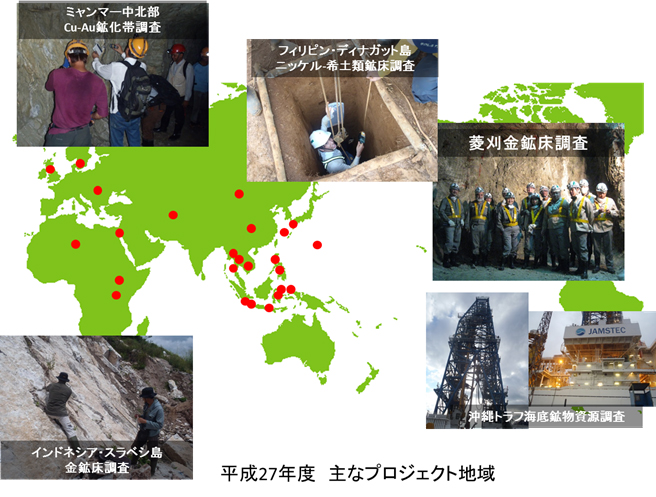Research topics
Principal research topics
Overseas gold deposit surveys (epithermal gold, nickel laterite, and other deposits in Southeast Asia, Mongolia, and North Africa), domestic epithermal gold deposits and seabed mineral resource deposits, geothermal resource development (geothermal geology and prevention of silica scale formation at geothermal power plants), experimental geochemistry (experimental with models to explain the mechanisms by which epithermal gold deposits are formed and development of geochemical analysis technologies)
Recent major topics of research
- Elucidating the origins of metal ore deposits formed in connection with the action of island-arc magma, for example epithermal gold deposits and porphyry copper deposits, and conducting resource surveys
- Elucidating the geochemical behavior of valuable metals accompanying nickel laterite deposits and evaluating associated resource quantities
- Elucidating the causes of mountain-type gold deposits and base metal deposits such as tin-tungsten and conducting resource surveys
- Forecasting transitions in volcanic activity through the analysis of volcanic ejecta
- Elucidating water-rock interactions as relates to geothermal resource development (identifying hydrothermally altered zones and preventing silica scale formation)
- Conducting experiments to reproduce mineral deposit formation models based on experimental geochemistry
- Developing technologies for recycling valuable metals that are inspired by accumulation mechanisms in the natural world
- Developing reference materials for analysis of solids in very small volumes
- Investigating seabed mineral resources, etc.
Research techniques include observation of rock and mineral specimens using microscopes; identification, structural observation, and determination of microscopic chemical composition of minerals by means of X-ray diffraction analysis, scanning electron microscope (SEM), and electron probe microanalyzer (EPMA); determination of chemical composition through whole-rock XRF (fluorescent X-ray analysis); and estimation of hydrothermal temperature and salt concentration by means of experiments in which fluid inclusions captured in minerals are heated and cooled. We also work jointly with other universities to date geological features and mineral deposits using 40Ar/39Ar by means of stability and radioisotope analysis and analysis of the hydrothermal origins of mineral deposits.
After suitable pre-processing, we use absorptiometers, the atomic absorption method, inductively coupled plasma (ICP) spectrometry, and ICP mass spectrometric analysis in the analysis and microanalysis of hydrothermal dissolved components. In recent years, we’re been pursuing field analysis using such tools as soil pH and Eh measurement, magnetic susceptibility measurement, handheld fluorescent X-ray analysis, and plasma emission devices.

Lectures
College
Introduction to Earth Systems Science, Field Earth Science, Environmental Earth Science, Resource Earth Science, Earth Systems Engineering Practicum
A postgraduate course
Resource Geology I, II
Keywords
Gold deposits, hydrothermal deposits, volcanic and geothermal geology, radioactive dating, field science, silica scale, rare-earth resources, seabed mineral resources, experimental geochemistry, rare metals, trace elements



